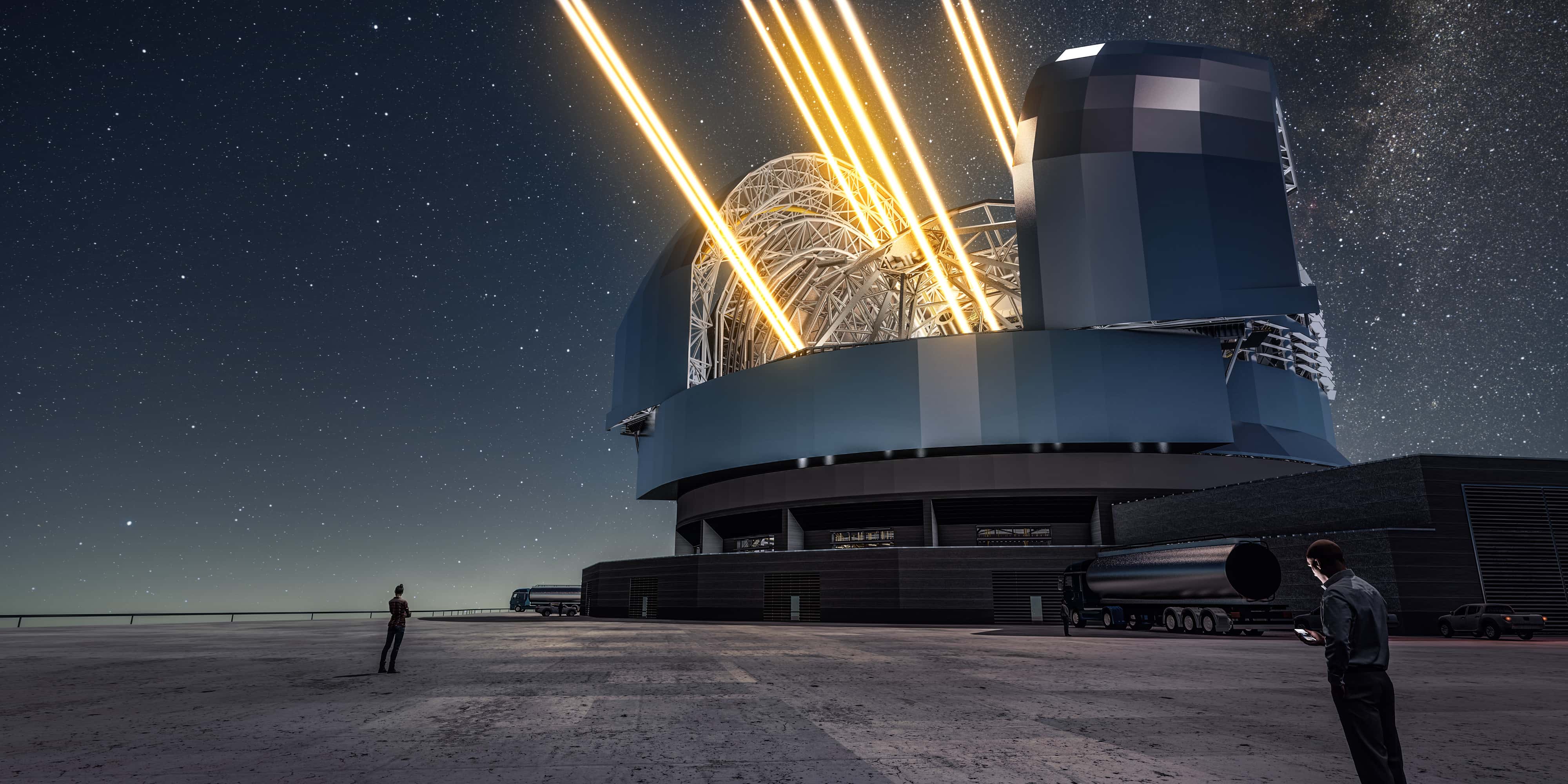
Technology developer and manufacturer Demcon and TNO delivered the first Laser Projection System last week. The destination is the European Southern Observatory (ESO), where TNO and ESO will test the system. Demcon company Focal and TNO will build nine systems for ESO’s Very Large Telescope and Extremely Large Telescope in Chile. The systems project so-called “laser guide stars” into the atmosphere to help the large telescopes better focus on astronomical objects far away. This will give astronomers sharper images of the universe. In doing so, they hope to make new discoveries, for example, about the universe’s evolution after the Big Bang and the formation of stars and galaxies.
Telescopes on Earth suffer from the atmosphere, which obscures the view due to turbulence. That is why mega-telescopes such as the Very Large Telescope (VLT) and the Extremely Large Telescope (ELT) stand atop a mountaintop. That is in Chile for the VLT, which consists of four telescopes, and the ELT, which is still under construction as the world’s largest telescope.
Artificial star as benchmark
To further reduce the effect of the remaining atmospheric disturbance, the Laser Projection System (LPS) has been developed. This instrument projects an artificial star at the outer edge of the atmosphere at an altitude of ninety kilometers. Because the properties of this “laser guide star” are known, the influence of the atmosphere can be deduced from observations of it. Astronomers use this information to correct the images they are really interested in.
ESO developed the ‘laser guide star’ technology more than a decade ago in collaboration with TNO, which built four LPS systems for one of the VLT telescopes. These were still prototypes, but they worked well and provided better observations. Reason for ESO to order nine more systems from TNO: three for the VLT (one for each of the other three telescopes) and six for the ELT. TNO decided to develop an improved, industrially mature version of the LPS, paying close attention to reliability, availability, maintainability, and safety. For this complex feat of precision optics and mechanics, TNO turned to Demcon focal, a specialist in optomechatronic systems. Demcon focal took care of the laser adjustment and control electronics.
Improved system
The main improvement of the laser tuning concerns maintenance, says Marko van Dalfsen, project leader at Demcon focal. “For service and maintenance, submodules can be replaced quickly and easily. As a result, the system has much less downtime. Astronomers can thus make more observations with their expensive telescopes.” In addition, the LPS’s performance has improved, adds TNO project manager Wouter Jonker. “It has become a robust system, so we can easily build it in series. If ESO wants nine, we deliver nine.” Construction is done at Demcon focal. Dalfsen: “This is where we build the parts supplied by TNO and Focal together into a complete system.”
Testing and training
For the first system, assembly was recently completed. ESO did a “test readiness review,” an important milestone before shipping to ESO in Garching, near Munich. There, TNO will conduct tests in a climate chamber to test the system under the conditions that occur atop a mountaintop, Jonker reports. “We will also train ESO personnel in service, maintenance, and use of the system. ESO is then expected to officially take delivery of the system in the summer and use it for the first time in observations with a VLT telescope in mid-2025. A Demcon focal and TNO team will be in Chile to help integrate the LPS on telescope.”
Meanwhile, Demcon focal and TNO can start building systems two through nine. ESO is in a big hurry to do so because astronomers are eager for telescopes that deliver even sharper images. ‘First light’ on the ELT is planned for 2027.
More work for Demcon focal
With the delivery of nine systems to ESO, Jonker knows the story is not over yet. “We are now putting the final touches to a license agreement with ESO. That stipulates that we can use everything we developed in this project in systems for other clients. Worldwide, our system is unique. ESO will soon have the very best equipment, and we know other observatories would like to have it. I estimate we can sell about twenty more pieces.” So a lot of work for Demcon focal could result from that.
Knowledge transfer to industry
Albert Borreman, managing director of Demcon focal, is pleased with all the work coming to him and also appreciates the knowledge transfer. “We often see that knowledge from TNO gradually trickles down to industry, in this case to Demcon focal. Think about how designs are made and how certain lens views and connection principles are applied. I think it’s great how the industry is brought along to slowly pick up new technology. For us, it was also important to meet ESO’s standards to position ourselves as a partner for astronomy projects from now on. With help from TNO, we learned that in this project.”

